Analysis of the Dynamics and Strength of the Symmetrically Loaded Bearing Structure of a Tank Car with Friction Bonds Implemented by Means of Elastic Elements in the Tank Supports
Abstract
:1. Introduction
- determining the vertical loading of the bearing structure of a tank car with friction bonds implemented by means of elastic elements in the tank supports;
- calculating the strength of the bearing structure of a tank car;
- to carry out the computer simulation of dynamic loading of the supporting structure of a tank car with friction bonds implemented by means of elastic elements in the tank car supports;
- determining the design service life and the safety factor of fatigue strength of the bearing structure of a tank car.
2. Materials and Methods
3. Results
4. Conclusions
- The vertical loading of the bearing structure of a tank car with friction bonds implemented by means of elastic elements in the tank supports was determined. The maximum vertical acceleration of the bearing structure of an empty tank car was approximately 1.4 m/s2 (0.14 g), and that of the bogies—approximately 8.94 m/s2 (0.94 g). Additionally, the motion of the car was evaluated as excellent. The application of friction bonds implemented by means of elastic elements can decrease the dynamic loading on a tank car in comparison with that of the prototype car by 35%.
- The strength of the bearing structure of a tank car was calculated. The maximum equivalent stresses were in the contact area between the center sill and the body bolster; they amounted to 252.8 MPa and did not exceed the allowable values for the 09G2S Steel. The maximum displacements were approximately 8.3 mm.
- Computer modeling of dynamic loading of the supporting structure of a tank car with friction bonds implemented by means of elastic elements in the tank supports was carried out. The maximum acceleration values were recorded in the upper part of the boiler and amounted to 1.52 m/s2. The conducted studies showed that the discrepancy between the results of analytical and numerical modeling is 7.9%, i.e., has good convergence.
- The service life and the safety factor of fatigue strength of the bearing structure of a tank car were determined. The design service life of the bearing structure of a tank car was 20% higher than that of the prototype car. The safety factor of fatigue strength equaled 4.1, which exceeded the allowable value by a factor of two.
5. Patents
Author Contributions
Funding
Institutional Review Board Statement
Informed Consent Statement
Data Availability Statement
Conflicts of Interest
References
- Štastniak, P.; Kurčík, P.; Pavlík, A. Design of a new railway wagon for intermodal transport with the adaptable loading platform. MATEC Web Conf. 2018, 235, 00030. [Google Scholar] [CrossRef]
- Dižo, J.; Harušinec, J.; Blatnický, M. Computation of modal properties of two types of freight wagon bogie frames using the finite element method. Manuf. Technol. 2018, 18, 208–214. [Google Scholar] [CrossRef] [Green Version]
- Štastniak, P.; Moravčík, M.; Smetanka, L.; Baran, P. Strength investigation of Main Frame in New Track friendly Railway Bogie. Manuf. Technol. 2018, 18, 315–320. [Google Scholar] [CrossRef] [Green Version]
- Dižo, J.; Harušinec, J.; Blatnický, M. Structural analysis of a modified freight wagon bogie frame. MATEC Web Conf. 2017, 134, 00010. [Google Scholar] [CrossRef]
- Iwnicki, S.D.; Stichel, S.; Orlova, A.; Hecht, M. Dynamics of railway freight vehicles. Veh. Syst. Dyn. 2015, 53, 995–1033. [Google Scholar] [CrossRef] [Green Version]
- Savoskin, A.N.; Akishin, A.A.; Yurchenko, D. Dynamics and optimization of a new double-axle flexible bogie for high-speed trains. Proc. Inst. Mech. Eng. Part F J. Rail Rapid Transit 2018, 232, 1549–1558. [Google Scholar] [CrossRef]
- Wu, Q.; Cole, C.; Spiryagin, M.; Ma, W. Preload on draft gear in freight trains. Proc. Inst. Mech. Eng. Part F J. Rail Rapid Transit 2018, 232, 1615–1624. [Google Scholar] [CrossRef]
- Nikitchenko, A.; Artiukh, V.; Shevchenko, D.; Murgul, V. Modeling of Operation of Elastic-frictional Draft Gear by NX Motion Software. Procedia Eng. 2017, 187, 790–796. [Google Scholar] [CrossRef]
- Shushmarchenko, V.O.; Fedorov, V.V.; Strinzha, A.M.; Fedosov-Nikonov, D.V. On the issue of technical diagnostics of tank cars for the transport of dangerous goods. Collect. Sci. Work. Railw. Roll. Stock 2020, 20, 89–95. [Google Scholar]
- Vatulia, G.; Falendysh, A.; Orel, Y.; Pavliuchenkov, M. Structural Improvements in a Tank Wagon with Modern Software Packages. Procedia Eng. 2017, 187, 301–307. [Google Scholar] [CrossRef]
- Ashtiani, I.H.; Rakheja, S.; Ahmed, W. Investigation of coupled dynamics of a railway tank car and liquid cargo subject to a switch-passing maneuver. Proc. Inst. Mech. Eng. Part F J. Rail Rapid Transit 2019, 233, 1023–1037. [Google Scholar] [CrossRef]
- Shi, H.; Wang, L.; Nicolsen, B.; Shabana, A.A. Integration of geometry and analysis for the study of liquid sloshing in railroad vehicle dynamics. Proc. Inst. Mech. Eng. Part K J. Multi-Body Dyn. 2017, 231, 608–629. [Google Scholar] [CrossRef]
- Shimanovsky, A. Recent research of dynamics and strength of tank vehicles. Mech. Mach. Mech. Mater. 2016, 3, 59–70. [Google Scholar]
- Lim, C.H.; Goo, B.C. Structural Strength Evaluation for Tank of Tank Car used for Carrying Asphalt. J. Korean Soc. Railw. 2007, 11, 1019–1025. [Google Scholar]
- Barkan, C.P.L.; Saat, M.R.R.; González, F., III; Treichel, T.T. Cooperative Research in Tank Car Safety Design. TR News 2013, 286, 12–19. [Google Scholar]
- Lovska, A.; Fomin, O.; Píštěk, V.; Kučera, P. Dynamic Load and Strength Determination of Carrying Structure of Wagons Transported by Ferries. J. Mar. Sci. Eng. 2020, 8, 902. [Google Scholar] [CrossRef]
- Fomin, O.V.; Lovska, A.O.; Plakhtii, O.A.; Nerubatskyi, V.P. The influence of implementation of circular pipes in load-bearing structures of bodies of freight cars on their physico-mechanical properties. Sci. Bull. Natl. Min. Univ. 2017, 6, 89–96. [Google Scholar]
- Atamanchuk, N.A.; Tsyganskaya, L. Directions of tank car design improvement for oil products transportation. Transp. Russ. Fed. 2013, 3, 14–17. [Google Scholar]
- Sobierzansky, A.N.; Tsyganskaya, L. Improvement of Tank Car Designs. Bull. Dnipropetr. Natl. Univ. Railw. Transp. Acad. V. Lazarian. 2010, 35, 25–28. [Google Scholar]
- Putyato, A.V. Computer simulation of hydrodynamic loading of tank car manhole area. Journal Bul. GSTU by. P.O. Sukhoi». 2009, 1, 79–86. [Google Scholar]
- Senko, V.I.; Shimanovsky, A.O.; Putyato, A.V. Research of ways to improve the strength of the parts of the boiler fasteners to the frame of the railway tank. Bull. Brest State Tech. Univ. 2004, 4, 54–57. [Google Scholar]
- Kelrikh, M.B.; Fomin, O.V.; Prokopenko, P.M.; Sova, S.S. Theoretical aspects of determining the remaining life of the tank-car for nonhazardous vans. Bull. Natl. Univ. Ukr. Named After Volodymyr Dahl. 2020, 5, 5–9. [Google Scholar] [CrossRef]
- Boyko, A.; Kononova, O. Calculation of tank car boiler strength under cyclic loading. XIII Int. Colloq. Mech. Fatigue Met. 2016, 484–490. Available online: https://core.ac.uk/download/pdf/60845322.pdf (accessed on 15 February 2022).
- Zaripov, R.Y.; Vasilevsky, V.P. Calculation of tank-car boiler strength under cyclic loading. Bull. Kazakh Acad. Transp. Commun. by M. Tynshpayev. M. Tynyshpayev 2017, 1, 53–59. [Google Scholar]
- Baranovsky, A.V.; Boyko, V.V.; Grigoriev, V.N.; Dimitrienko, I.P.; Egorov, V.I.; Ermolenko, A.F.; Kaminsky, V.A.; Morozov, A.P.; Pozdnyakov, N.A.; Pupkov, A.P. Tank wagon. Russian Patent 2123444, 23 April 1997. [Google Scholar]
- Savushkin, R.A.; Kyakk, K.V.; Lavrenko, D.T.; Kalugin, A.V.; Shevchenko, D.V. Support assembly of the railway tank car boiler. Russian Utility Model 169984, 1 August 2016. [Google Scholar]
- Shipilov, G.V.; Zuban, A.T.; Barkov, I.V. Device for fastening the boiler of a railway tank on the platform frame (options). Russian Patent 2207260, 17 February 1999. [Google Scholar]
- Savushkin, R.A.; Kyakk, K.V.; Fedorov, S.A.; Lobanov, M.S.; Shevchenko, D.V.; Popovich, S.I. Rail tank boiler support unit. Russian Patent 175344, 31 March 2017. [Google Scholar]
- 4-Axle Frameless Tankers. Available online: http://scaletrainsclub.com/board/viewtopic.php?style=7&t=2056&start=20 (accessed on 29 July 2016).
- Fomin, O.V.; Lovska, A.O. Tank car with spring elements in the load-bearing structure. Ukraine Patent 148122, 20 January 2021. [Google Scholar]
- Demin, Y.V.; Chernyak, G.Y. Fundamentals of Wagon Dynamics; Tutorial; KUETT: Kiev, Ukraine, 2003; 270p. [Google Scholar]
- 7598:2014; DSTU. Freight Wagons. General Requirements for Calculations and Design of New and Modernized Wagons of 1520 mm Track (Non-Self-Propelled). UkrNDNTS: Kiev, Ukraine, 2015; 162p.
- 33211-2014; GOST. Freight Wagons. Requirements for Strength and Dynamic Properties. FGUP “STANDARTINFORM”: Moskow, Russia, 2016; 54p.
- Kelrykh, M.; Fomin, O. Perspective directions of planning carrying systems of gondolas. Metall. Min. Ind. 2014, 6, 64–67. [Google Scholar]
- Lovska, A.; Fomin, O.; Kučera, P.; Píštěk, V. Calculation of Loads on Carrying Structures of Articulated Circular-Tube Wagons Equipped with New Draft Gear Concepts. Appl. Sci. 2020, 10, 7441. [Google Scholar] [CrossRef]
- Lovska, A. Simulation of loads on the carrying structure of an articulated flat car in combined transportation. Int. J. Eng. Technol. 2018, 7, 140–146. [Google Scholar] [CrossRef] [Green Version]
- Vatulia, G.; Komagorova, S.; Pavliuchenkov, M. Optimization of the truss beam. Verification of the calculation results. MATEC Web Conf. 2018, 230, 02037. [Google Scholar] [CrossRef]
- Lovska, A.; Fomin, O.; Píštěk, V.; Kučera, P. Dynamic Load Modelling within Combined Transport Trains during Transportation on a Railway Ferry. Appl. Sci. 2020, 10, 5710. [Google Scholar] [CrossRef]
- Píštěk, V.; Kučera, P.; Fomin, O.; Lovska, A. Effective Mistuning Identification Method of Integrated Bladed Discs of Marine Engine Turbochargers. J. Mar. Sci. Eng. 2020, 8, 379. [Google Scholar] [CrossRef]
- Lovska, A.O. Computer simulation of wagon body bearing structure dynamics during transportation by train ferry. East.-Eur. J. Enterp. Technol. 2015, 3, 9–14. [Google Scholar]
- Ustich, P.A.; Karpych, V.A.; Ovechnikov, M.N. Reliability of Non-Traction Rail Rolling Stock; IG «Variant»: Moscow, Russia, 1999; 415p. [Google Scholar]
- Senko, V.I.; Makeev, S.V.; Komissarov, V.V.; Skorokhodov, S.A. Features of determination of coefficient of the stock resistance of fatigue of designs of the rolling stock. Bull. BSUT Sci. Transp. 2018, 1, 5–9. [Google Scholar]
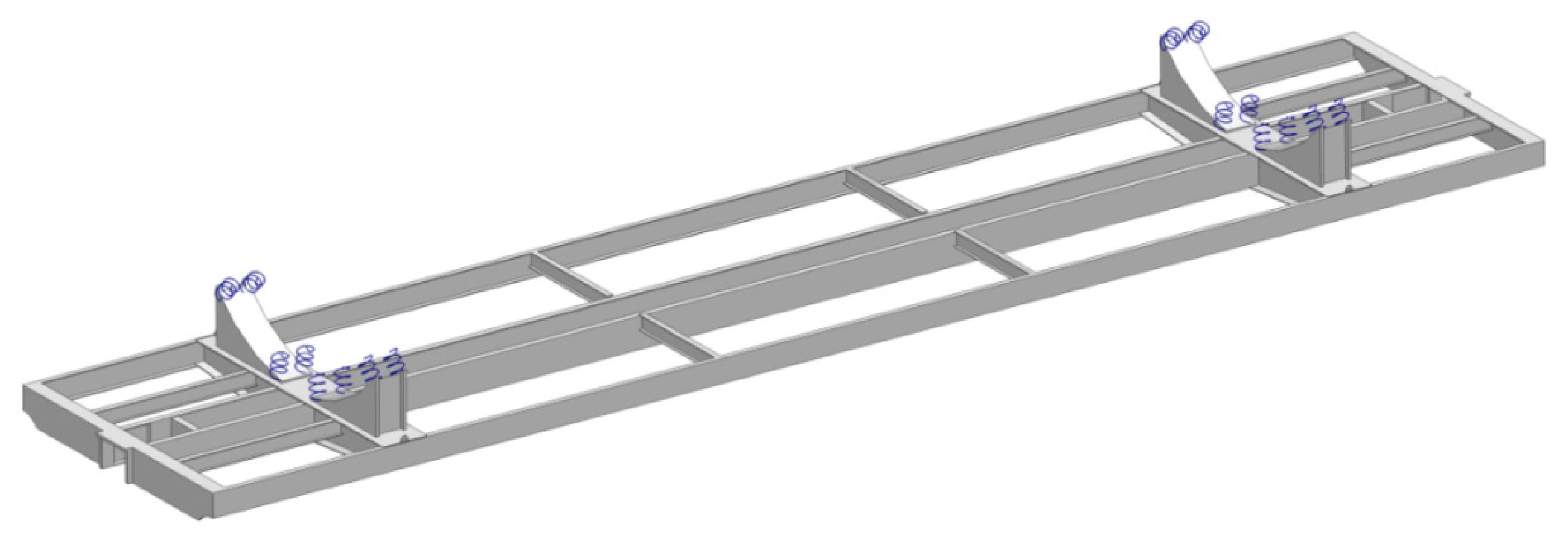
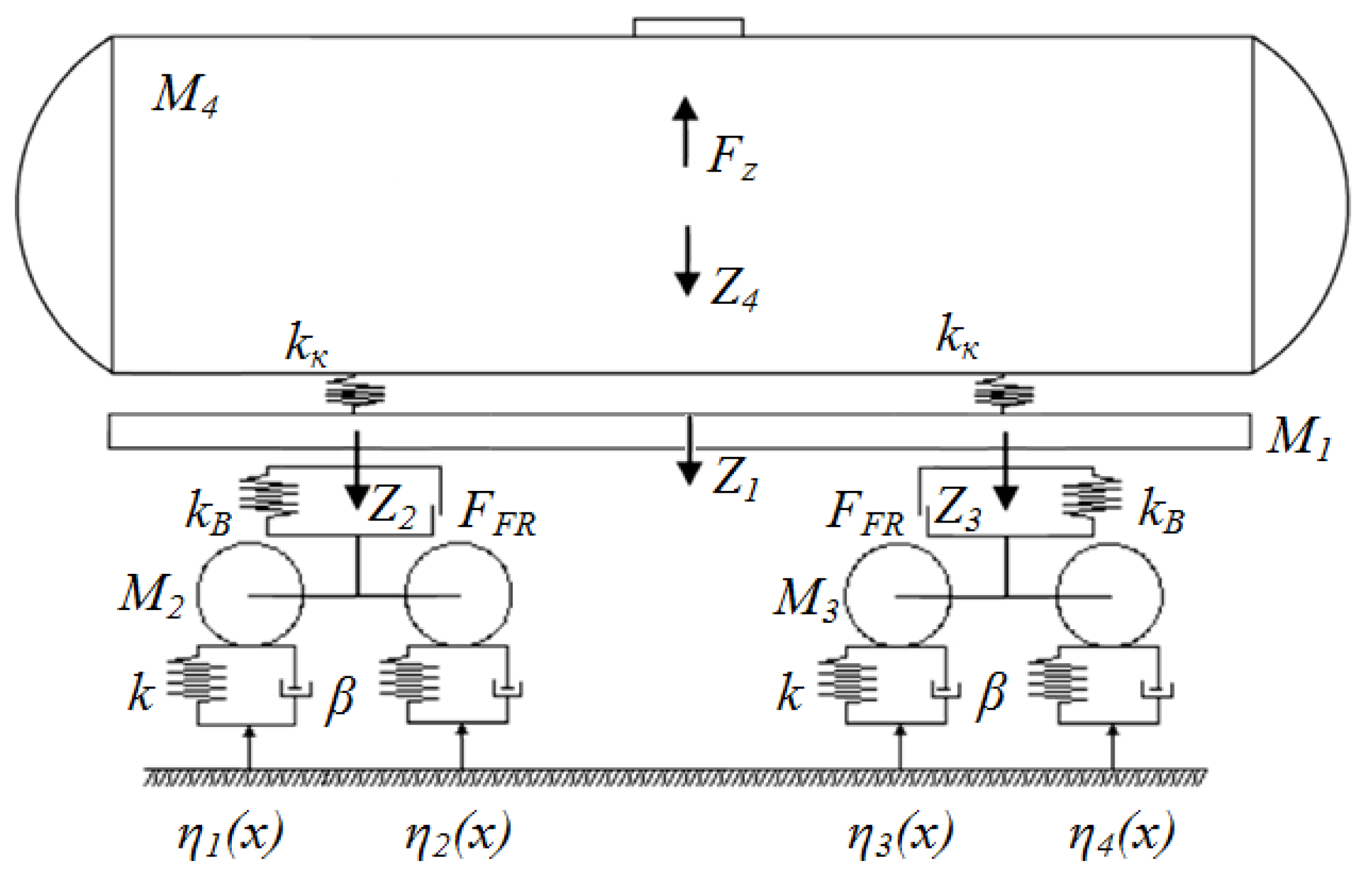

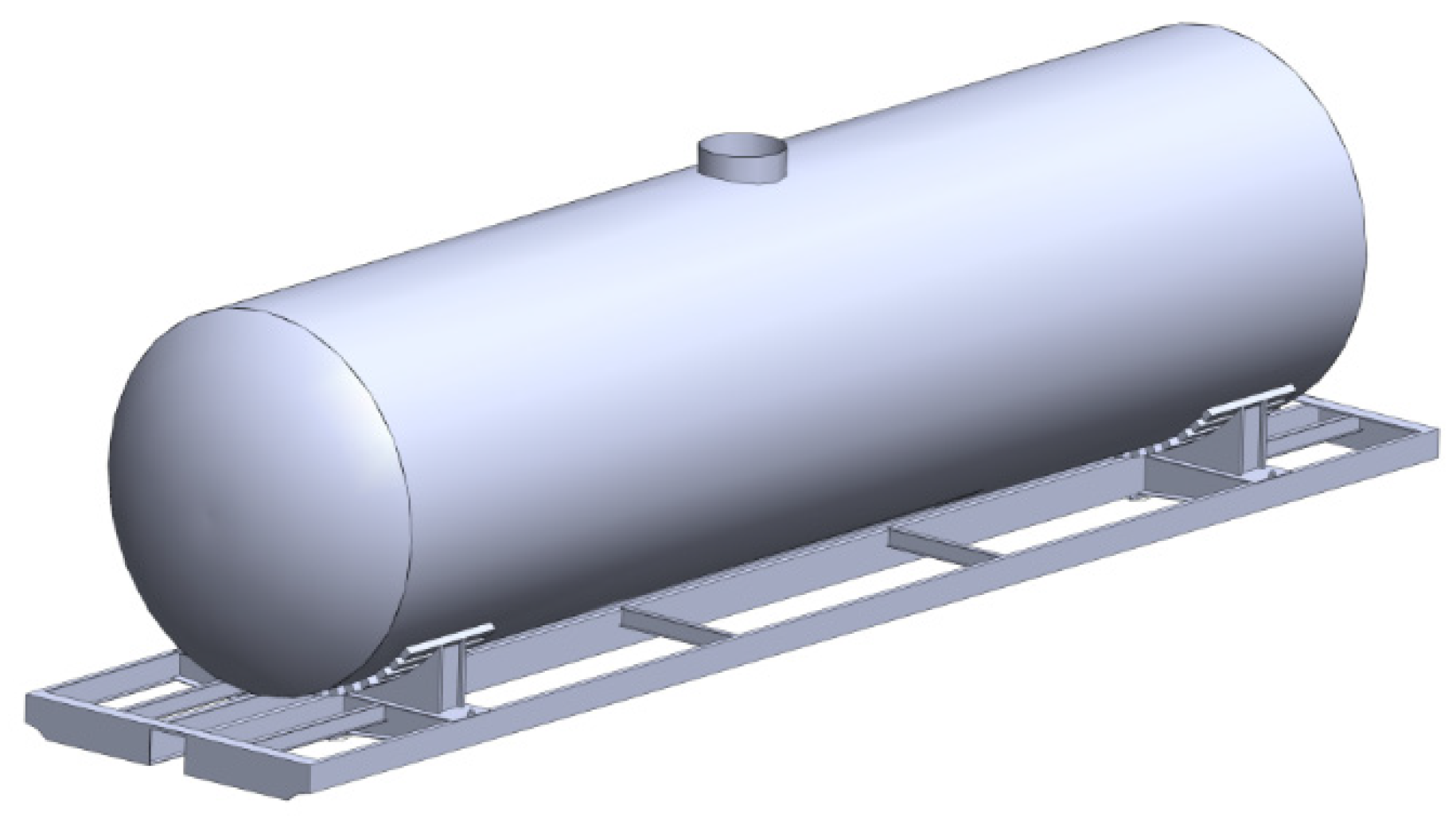
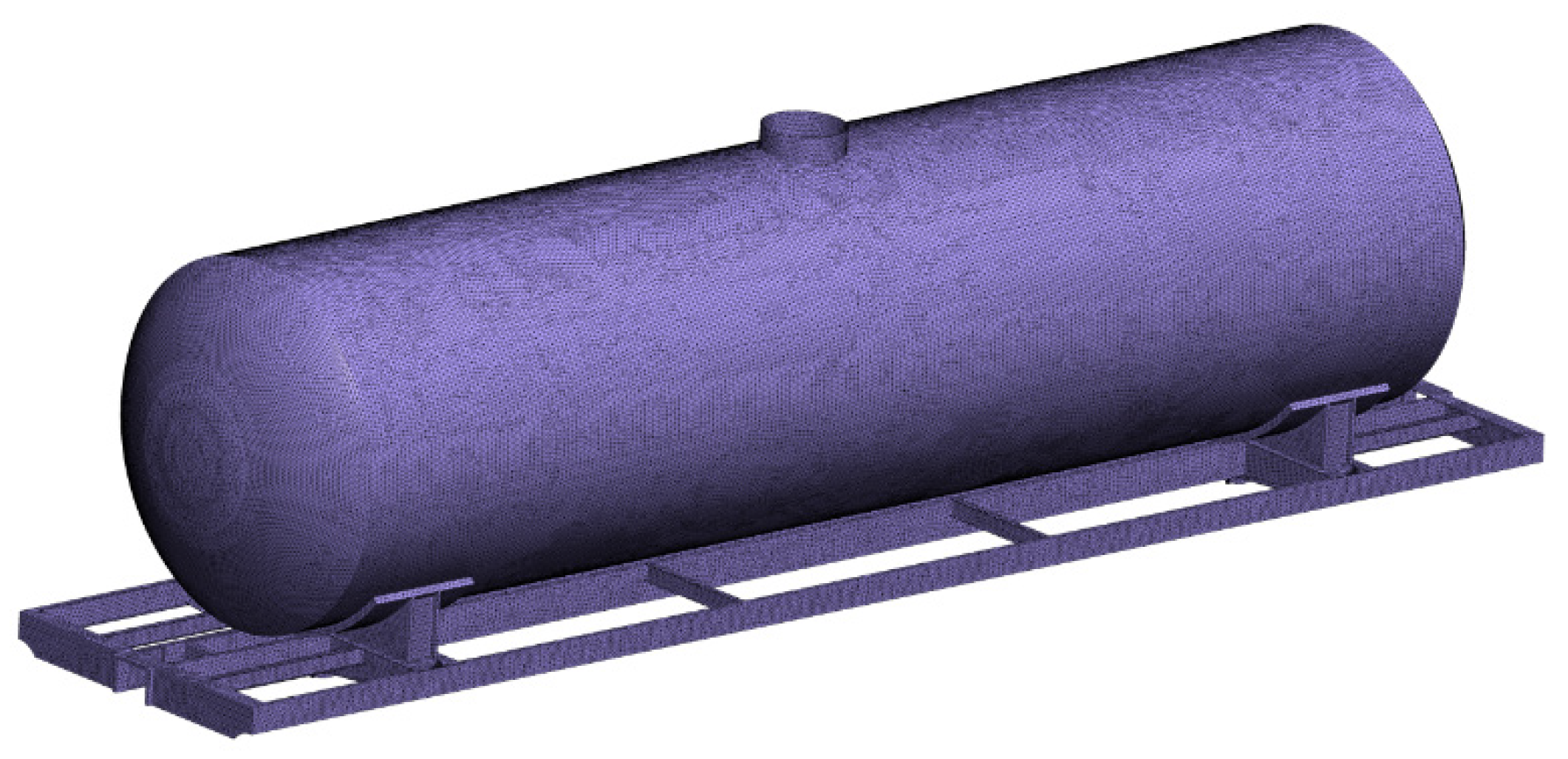
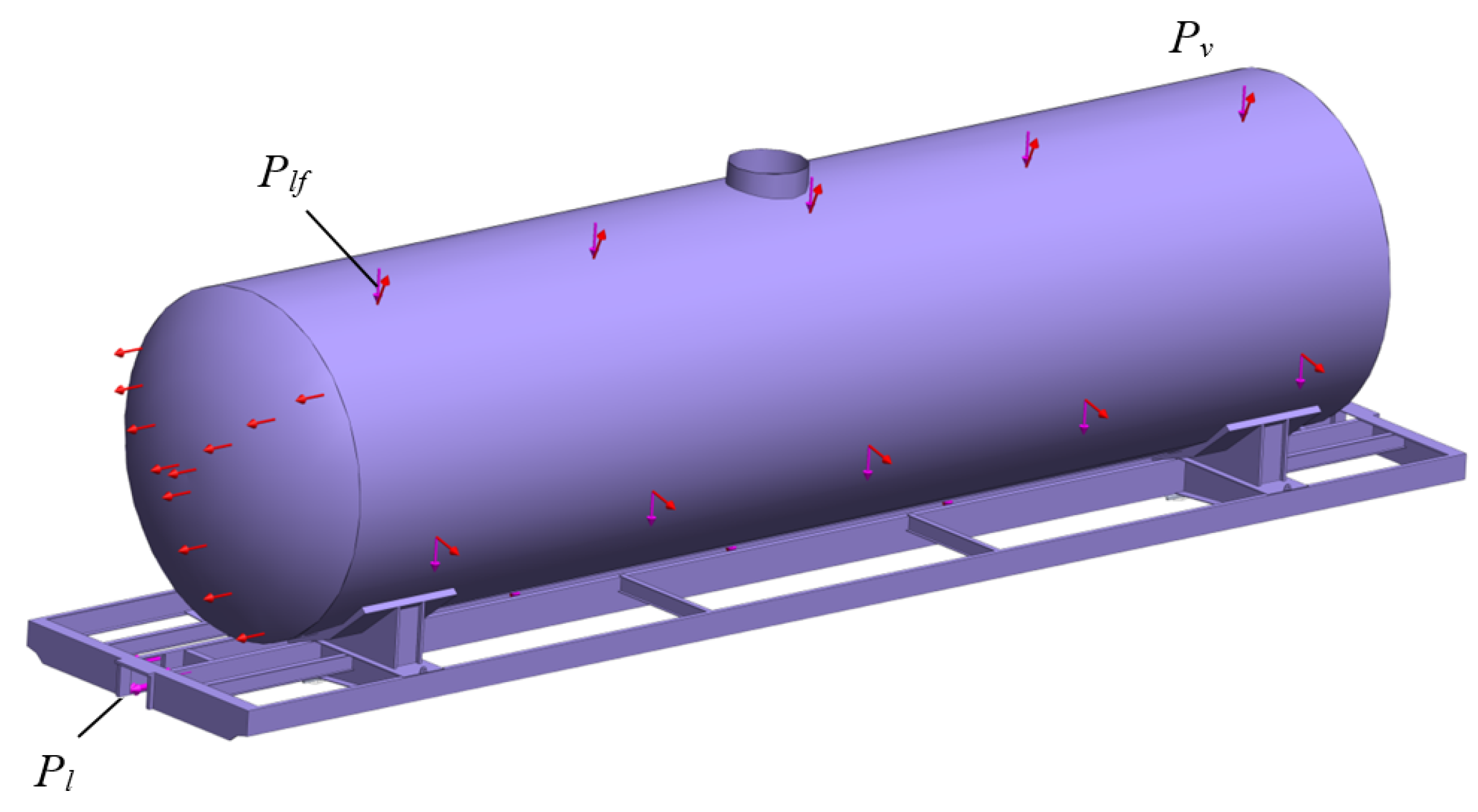
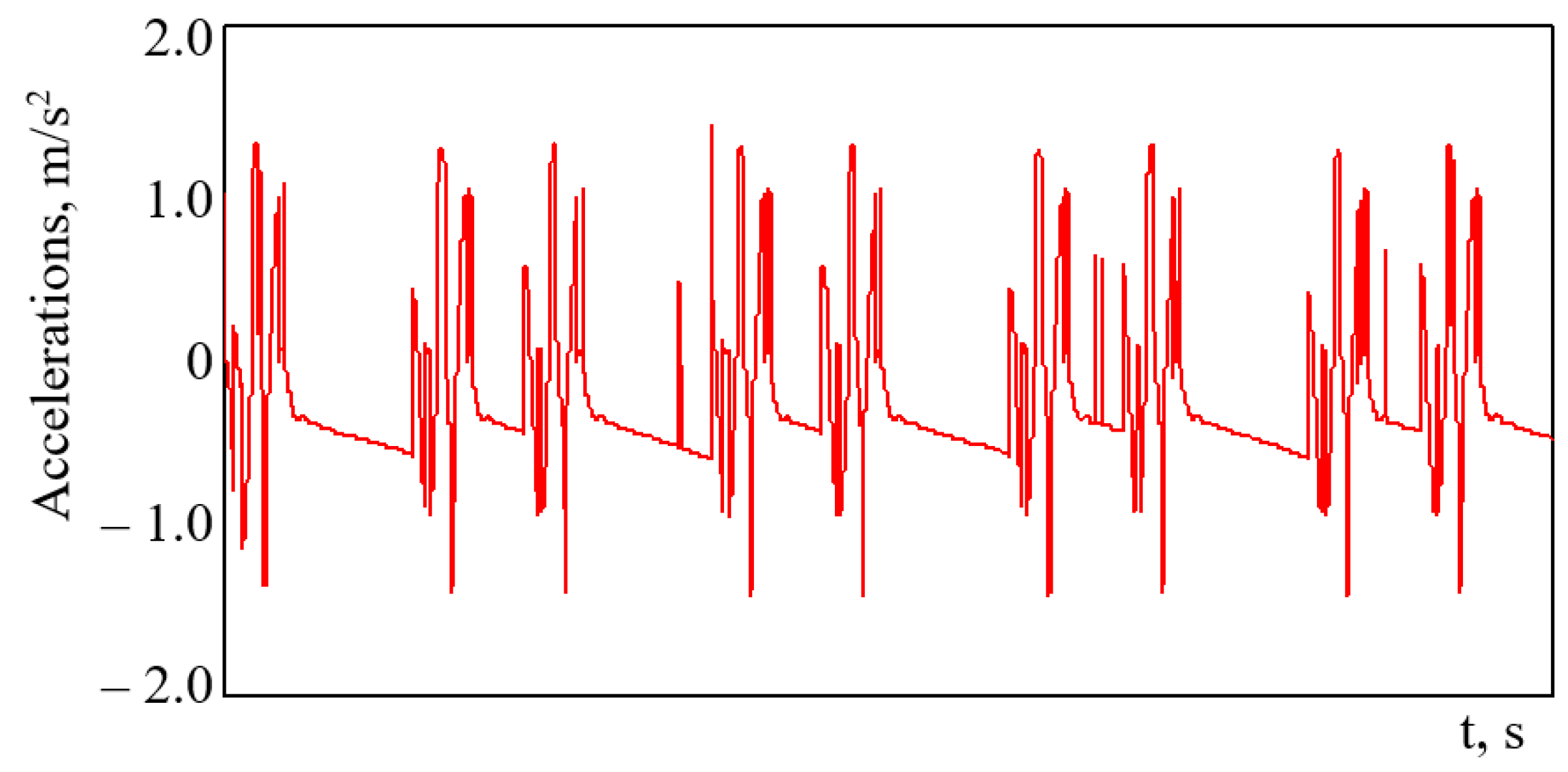
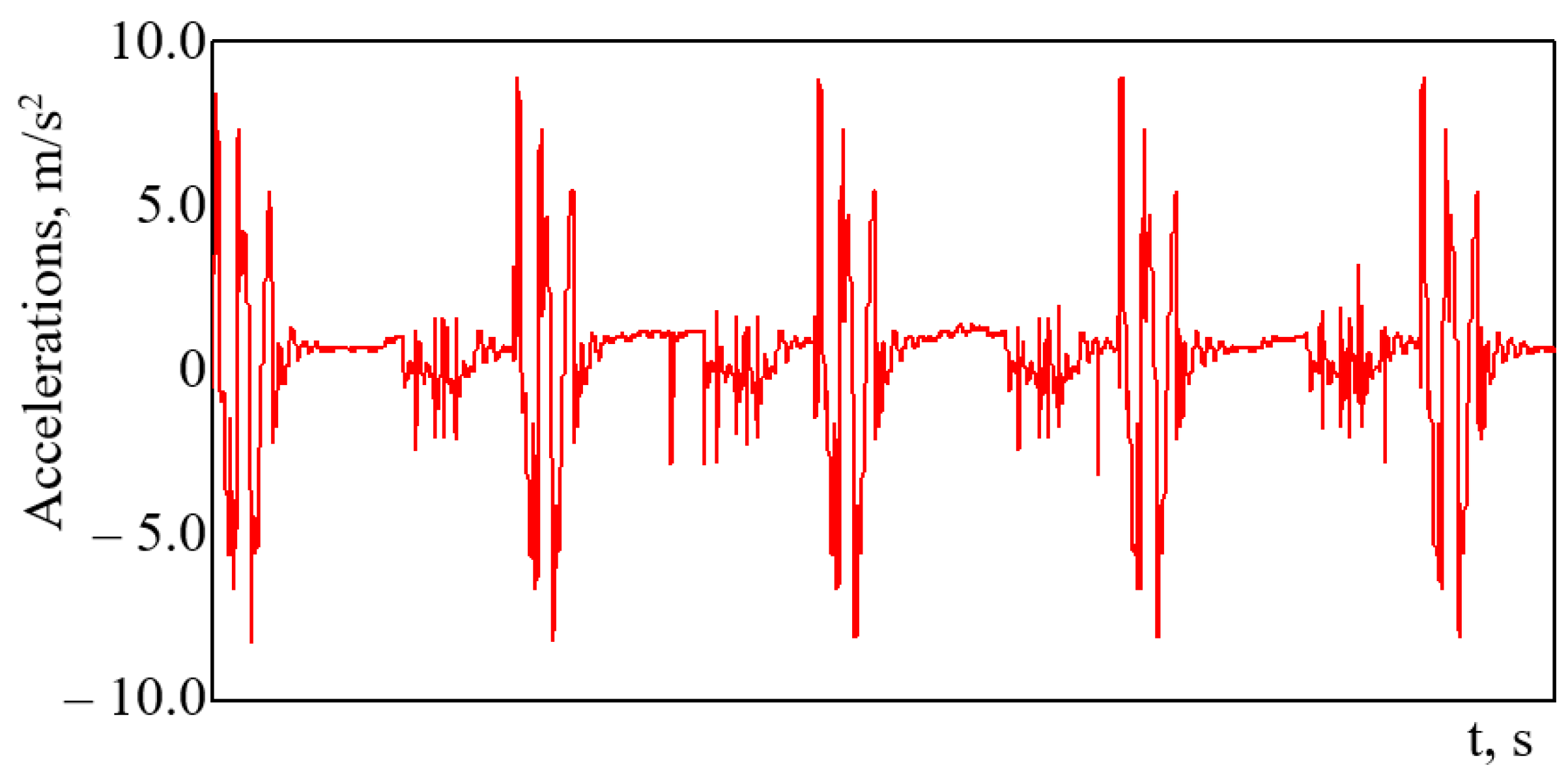
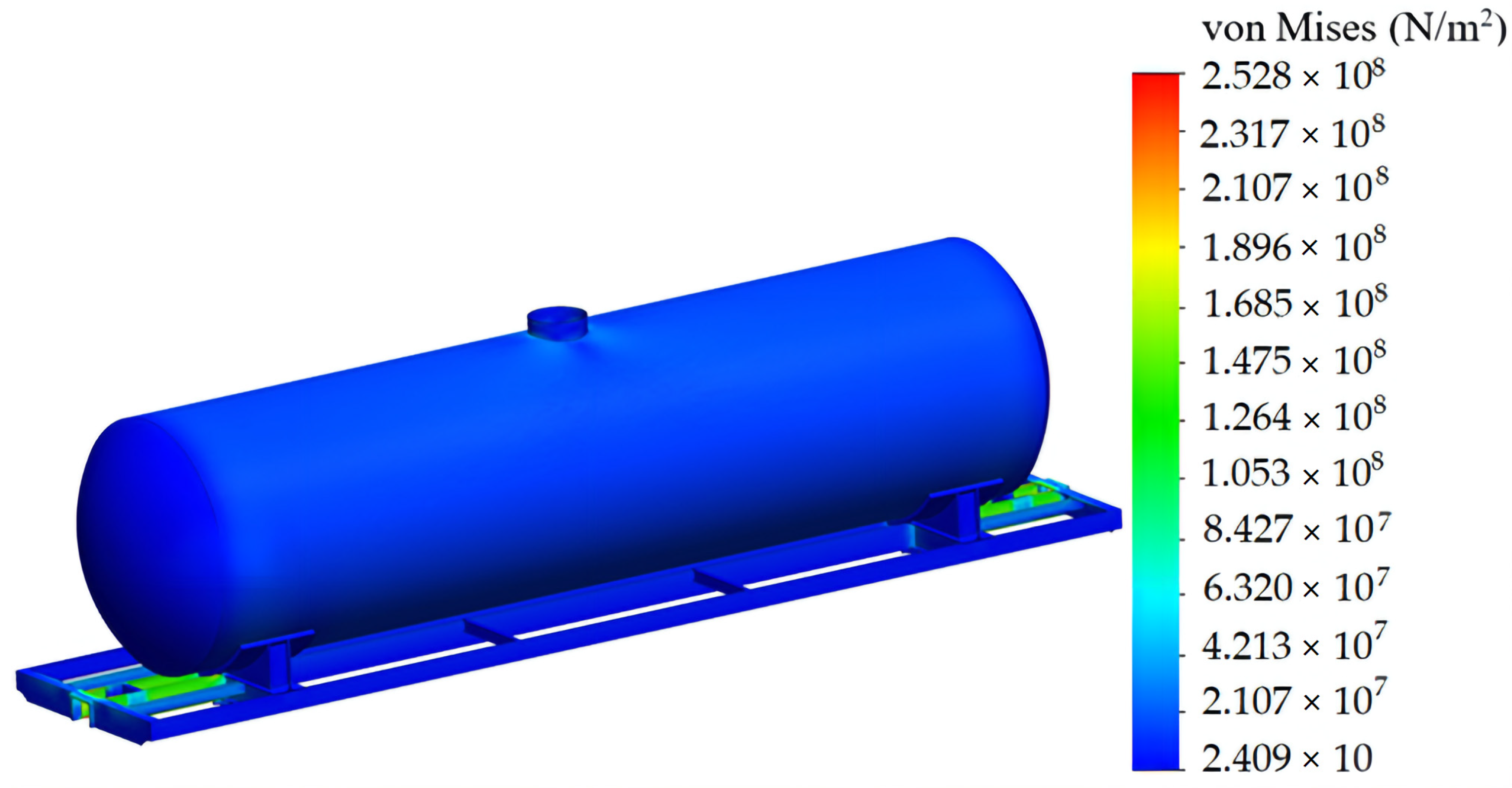

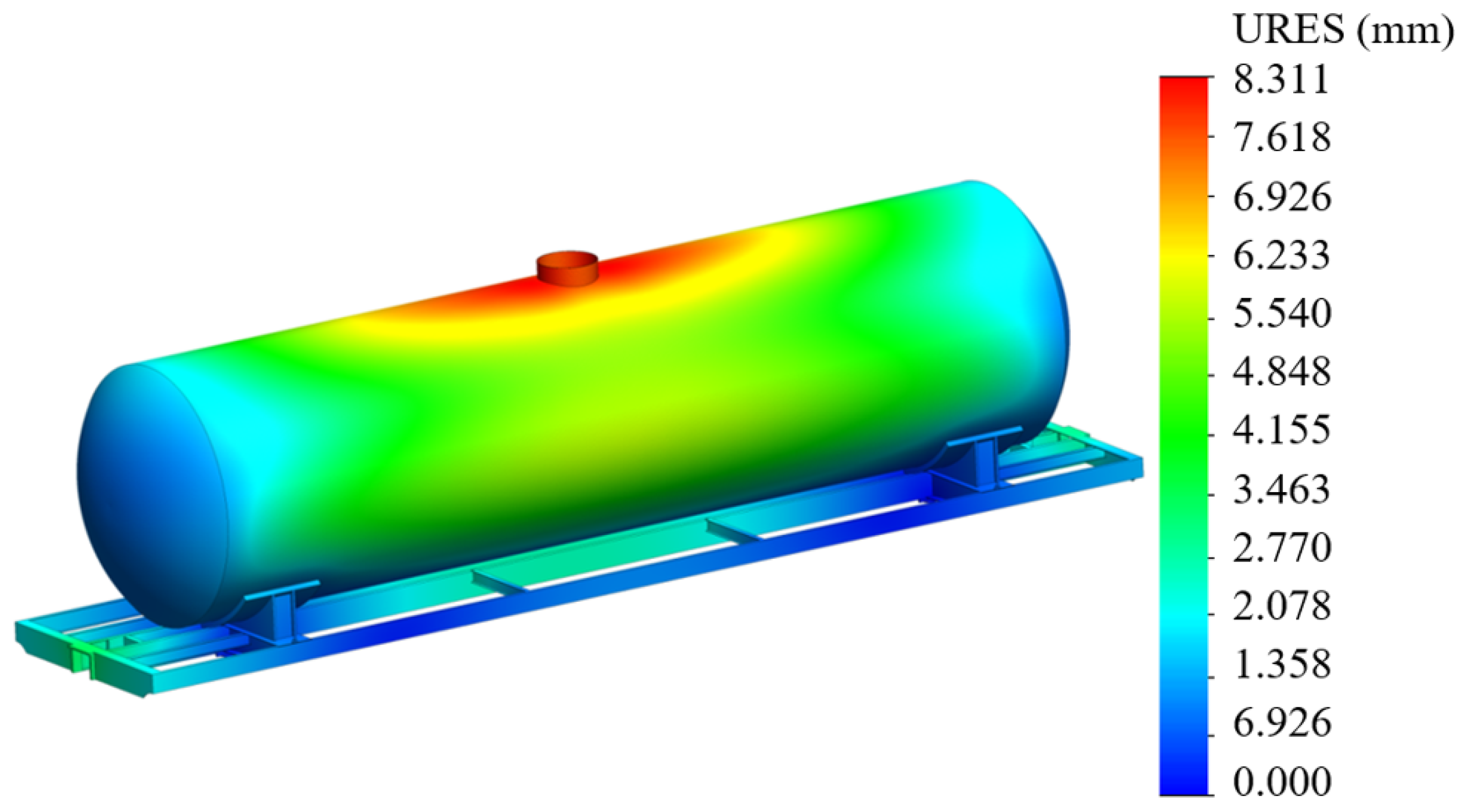
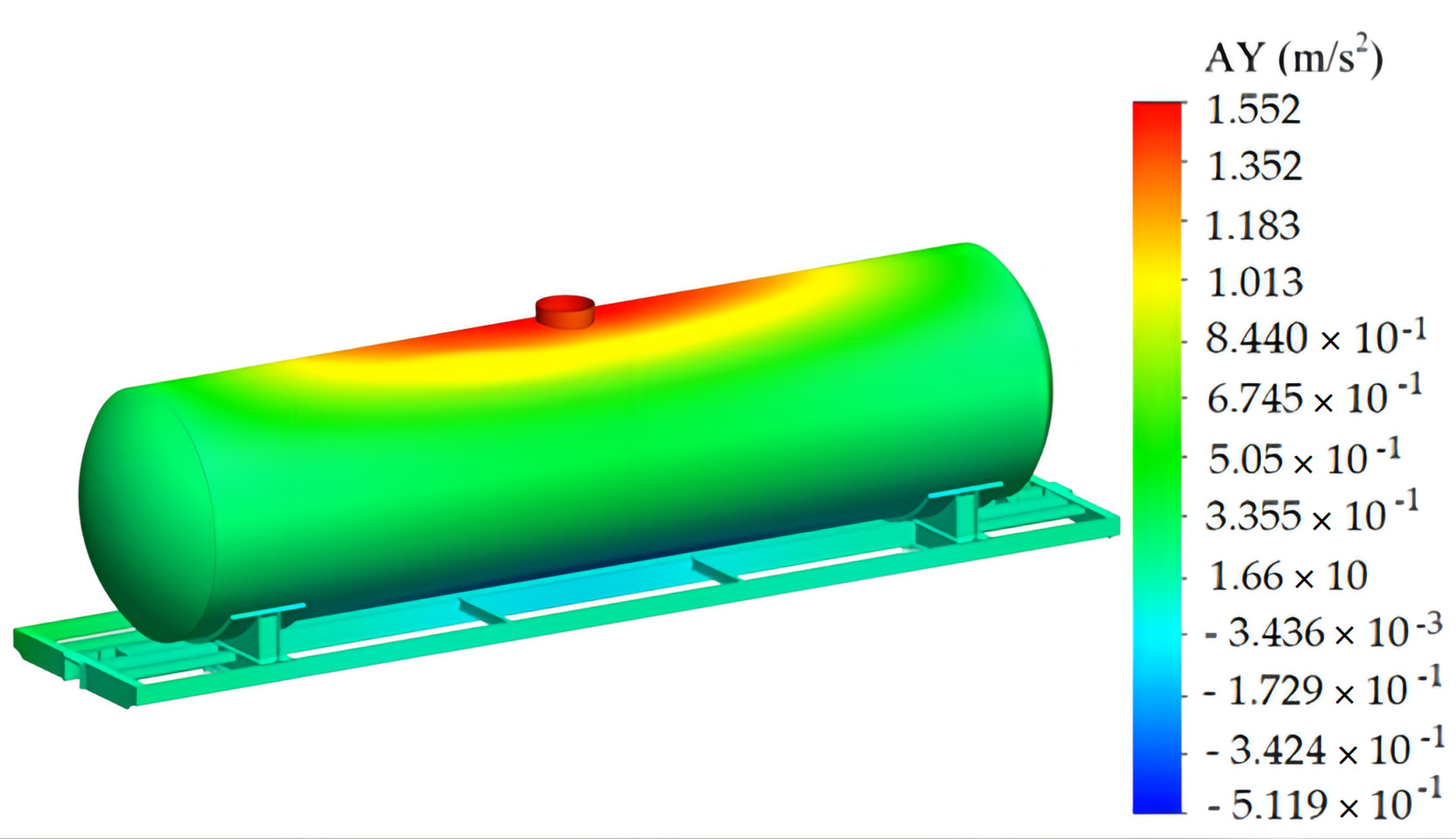
| Parameter | Value |
|---|---|
| BEARING STRUCTURE | |
| Mass, tons | 14.9 |
| BOGIES | |
| Mass, tons | 4.3 |
| Spring suspension rigidity, kN/m | 8000 |
| Relative friction coefficient | 0.1 |
| TRACK | |
| Damping coefficient, kN∙s/m | 200 |
| Rigidity, kN/m | 100,000 |
| Irregularity amplitude, m | 0.01 |
| Irregularity length, m | 25 |
| Parameter | Value |
|---|---|
| Modulus of elasticity, MPa | 2.1 × 105 |
| Poisson’s ratio | 0.28 |
| Shear modulus, MPa | 7.9 × 103 |
| Mass density, kg/m3 | 7800 |
| Tensile strength, MPa | 490 |
| Yield strength, MPa | 345 |
| Tank Car Model | Bearing Structure Mass, Tons | Acceleration, m/s2 | |
|---|---|---|---|
| Bearing Structure | Bogies | ||
| 15-1454 | 13.8 | 1.58 | 8.69 |
| 15-1480 | 15.3 | 1.48 | 8.83 |
| 15-1487 | 12.1 | 1.83 | 8.44 |
| 15-1514 | 12.5 | 1.77 | 8.48 |
| 15-1520 | 14.0 | 1.56 | 8.7 |
| 15-1522 | 16.1 | 1.45 | 8.89 |
| 15-1525 | 12.6 | 1.75 | 8.5 |
Publisher’s Note: MDPI stays neutral with regard to jurisdictional claims in published maps and institutional affiliations. |
© 2022 by the authors. Licensee MDPI, Basel, Switzerland. This article is an open access article distributed under the terms and conditions of the Creative Commons Attribution (CC BY) license (https://creativecommons.org/licenses/by/4.0/).
Share and Cite
Fomin, O.; Gerlici, J.; Lovska, A.; Kravchenko, K. Analysis of the Dynamics and Strength of the Symmetrically Loaded Bearing Structure of a Tank Car with Friction Bonds Implemented by Means of Elastic Elements in the Tank Supports. Symmetry 2022, 14, 727. https://doi.org/10.3390/sym14040727
Fomin O, Gerlici J, Lovska A, Kravchenko K. Analysis of the Dynamics and Strength of the Symmetrically Loaded Bearing Structure of a Tank Car with Friction Bonds Implemented by Means of Elastic Elements in the Tank Supports. Symmetry. 2022; 14(4):727. https://doi.org/10.3390/sym14040727
Chicago/Turabian StyleFomin, Oleksij, Juraj Gerlici, Alyona Lovska, and Kateryna Kravchenko. 2022. "Analysis of the Dynamics and Strength of the Symmetrically Loaded Bearing Structure of a Tank Car with Friction Bonds Implemented by Means of Elastic Elements in the Tank Supports" Symmetry 14, no. 4: 727. https://doi.org/10.3390/sym14040727









